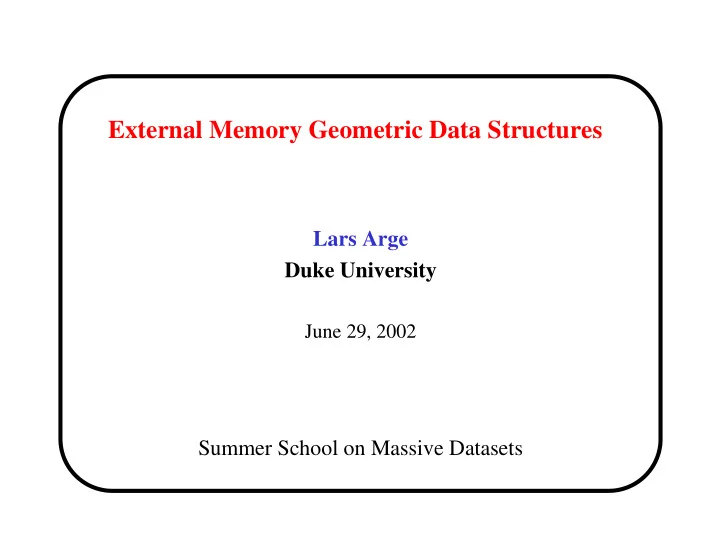

External�Memory�Geometric�Data�Structures Lars�Arge Duke�University June�29,�2002 Summer�School�on�Massive�Datasets
External�memory�data�structures So�Far�So�Good • Yesterday�we�discussed “dimension�1.5”�problems: – Interval�stabbing and�point�location • We�developed�a�number�of�useful�tools/techniques – Logarithmic�method – Weight-balanced�B-trees – Global�rebuilding • On Thursday�we�also�discussed�several�tools/techniques – B-trees – Persistent�B-trees – Construction�using�buffer�technique Lars�Arge 2
External�memory�data�structures Interval�Management • Maintain� N intervals�with�unique�endpoints�dynamically�such�that� stabbing�query�with�point� x� can�be�answered�efficiently x • Solved�using�external�interval�tree • We�obtained�the�same�bounds�as�for�the� 1d case – Space:� O ( N/B ) + – Query:� (log T ) O B N B – Updates:�������������������I/Os (log ) O N B Lars�Arge 3
External�memory�data�structures Interval�Management • External�interval�tree: Θ – Fan-out�������������weight-balanced�B-tree on�endpoints ( B ) – Intervals�stored�in� O ( B )�secondary�structure�in�each�internal�node – Query�efficiency�using�filtering – Bootstrapping used�to�avoid� O ( B )�search�cost�in�each�node * Size� O ( B 2 )�underflow�structure�in�each�node * Constructed�using�sweep�and�persistent�B-tree * Dynamic�using�global�rebuilding v v $m$�blocks Θ ( B ) Lars�Arge 4
External�memory�data�structures 3-Sided�Range�Searching • Interval�management�corresponds�to�simple�form�of� 2d range�search (x 1 ,x 2 ) x 1 x 2 (x,x) x • More�general�problem:�Dynamic 3-sidede�range�searching – Maintain�set�of�points�in�plane�such that�given�query�( q 1 , q 2 ,� q 3 ),�all�points ( x , y )�with� q 1 ≤ x ≤ q 2 and� y ≥ q 3 can q 3 be�found�efficiently q 1 q 2 Lars�Arge 5
External�memory�data�structures 3-Sided�Range�Searching�:�Static�Solution • Construction:�Sweep top-down�inserting� x in�persistent�B-tree�at�( x , y ) – O ( N/B )�space N – I/O�construction�using�buffer�technique ( log ) O N B B • Query�( q 1 , q 2 ,� q 3 ):�Perform�range�query�with�[ q 1 , q 2 ]�in�B-tree�at� q 3 + – I/Os (log T ) O B N B • Dynamic�using�logarithmic�method (log 2 N – Insert: ) O B q 3 + (log 2 – Query:�� T ) O B N B q 1 q 2 (log ) • Improve�to������������������?��Deletes? O N B Lars�Arge 6
External�memory�data�structures Internal�Priority�Search�Tree 9 16.20 4 16 5,6 19,9 1 5 13 19 1,2 9,4 13,3 20,3 1 4 5 9 13 16 19 20 4,1 • Base�tree�on� x -coordinates with�nodes�augmented�with�points • Heap�on� y -coordinates – Decreasing y� values�on�root-leaf�path – ( x , y )�on�path�from�root�to�leaf�holding� x – If� v holds�point�then� parent ( v )�holds�point Lars�Arge 7
External�memory�data�structures Internal�Priority�Search�Tree 9 10,21 16.20 Insert�(10,21) 4 16 5,6 19,9 1 5 13 19 1,2 9,4 13,3 20,3 1 4 5 9 13 16 19 20 4,1 • Linear�space • Insert�of�( x , y )�(assuming�fixed� x -coordinate�set): – Compare�y�with� y -coordinate�in�root – Smaller:�Recursively�insert ( x , y )�in�subtree on�path�to� x – Bigger:�Insert�in�root�and�recursively�insert�old�point�in�subtree � O (log N )�update Lars�Arge 8
External�memory�data�structures Internal�Priority�Search�Tree 9 16.20 4 4 16 5,6 19,9 4 19 1 5 13 19 1,2 9,4 13,3 20,3 1 4 5 9 13 16 19 20 4,1 • Query with�( q 1 , q 2 ,� q 3 )�starting�at�root�v: – Report�point�in� v if�satisfying�query – Visit�both�children�of� v if�point�reported – Always�visit�child(s)�of� v on�path(s)�to� q 1 and q 2 � O (log N+T )�query Lars�Arge 9
External�memory�data�structures Externalizing�Priority�Search�Tree 9 16.20 4 16 5,6 19,9 1 5 13 19 1,2 9,4 13,3 20,3 1 4 5 9 13 16 19 20 4,1 • Natural�idea:�Block�tree • Problem:� – O (log N ) I/Os�to�follow�paths�to�to q 1 and q 2 B – But O ( T )�I/Os�may�be�used�to�visit�other�nodes�(“overshooting”)� + � (log ) O N T query� B Lars�Arge 10
External�memory�data�structures Externalizing�Priority�Search�Tree 9 16.20 4 16 5,6 19,9 1 5 13 19 1,2 9,4 13,3 20,3 1 4 5 9 13 16 19 20 4,1 • Solution�idea: – Store� B points�in�each�node� � * O ( B 2 )�points�stored�in�each�supernode * B output�points�can�pay�for�“overshooting” – Bootstrapping: * Store� O ( B 2 )�points�in�each�supernode in�static�structure Lars�Arge 11
External�memory�data�structures External�Priority�Search�Tree • Base�tree:�Weight-balanced�B-tree�on� x -coordinates�( a,k=B ) • Points�in�“heap�order”: Θ – Root�stores� B top�points�for�each�of�the����������child�slabs ( B ) – Remaining�points�stored�recursively • Points�in�each�node�stored�in�“ O ( B 2 )-structure” – Persistent�B-tree�structure�for�static�problem � Θ ( B ) Linear�space Lars�Arge 12
External�memory�data�structures External�Priority�Search�Tree • Query with�( q 1 , q 2 ,� q 3 )�starting�at�root� v : – Query� O ( B 2 )-structure�and�report�points�satisfying�query – Visit�child� v if * v on�path�to� q 1 or q 2 * All�points�corresponding�to� v satisfy�query Lars�Arge 13
External�memory�data�structures External�Priority�Search�Tree • Analysis: + = + 2 T T – I/Os�used�to�visit�node� v (log ) ( 1 ) O B O v v B B B – (log ) nodes�on�path�to� q 1 or q 2 O N B – For�each�node� v not�on�path�to� q 1 or q 2� visited,� B� points�reported� in� parent ( v ) � + (log T ) query O B N B Lars�Arge 14
External�memory�data�structures External�Priority�Search�Tree • Insert�( x,y ) (assuming�fixed� x -coordinate�set�– static�base�tree): – Find�relevant�node� v: * Query� O ( B 2 )-structure�to�find B� points�in�root�corresponding to�node� u on�path�to� x u * If� y smaller�than� y -coordinates of�all� B points�then�recursively search�in� u – Insert�( x,y ) in� O ( B 2 )-structure�of� v – If� O ( B 2 )-structure�contains� >B points�for�child� u ,�remove�lowest� point�and�insert�recursively�in� u • Delete:�Similarly Lars�Arge 15
External�memory�data�structures External�Priority�Search�Tree • Analysis: – Query�visits�������������������nodes (log ) O N B – O ( B 2 )-structure�queried/updated�in�each�node * One�query * One�insert�and�one�delete u • O ( B 2 )-structure�analysis: + = 2 – Query: (log / ) ( 1 ) O B B B O B – Update�in� O ( 1 )�I/Os�using�update block�and�global�rebuilding � I/Os (log ) O N B Lars�Arge 16
External�memory�data�structures Removing�Fixed� x -coordinate�Set�Assumption • Deletion: – Delete�point�as�previously v – Delete� x -coordinate�from�base tree�using�global�rebuilding � (log ) I/Os�amortized O N B • Insertion: – Insert� x -coordinate�in�base�tree v’ v’’ and�rebalance�(using�splits) – Insert�point�as�previously • Split:�Boundary�in� v becomes�boundary�in� parent ( v ) Lars�Arge 17
External�memory�data�structures Removing�Fixed� x -coordinate�Set�Assumption • Split:�When� v splits� B new�points�needed�in� parent ( v ) • One�point�obtained�from� v’ ( v’’ )�using�“bubble-up”�operation: – Find�top�point� p in� v’ – Insert� p in� O ( B 2 )-structure� v’ – Remove� p from� O ( B 2 )-structure�of� v’ v’’ – Recursively�bubble-up�point�to� v (log ( )) • Bubble-up in�����������������������I/Os O w v B – Follow�one�path�from� v to�leaf – Uses� O ( 1 )�I/O�in�each�node � = Split�in�������������������������������������������I/Os ( log ( )) ( ( )) O B w v O w v B Lars�Arge 18
Recommend
More recommend